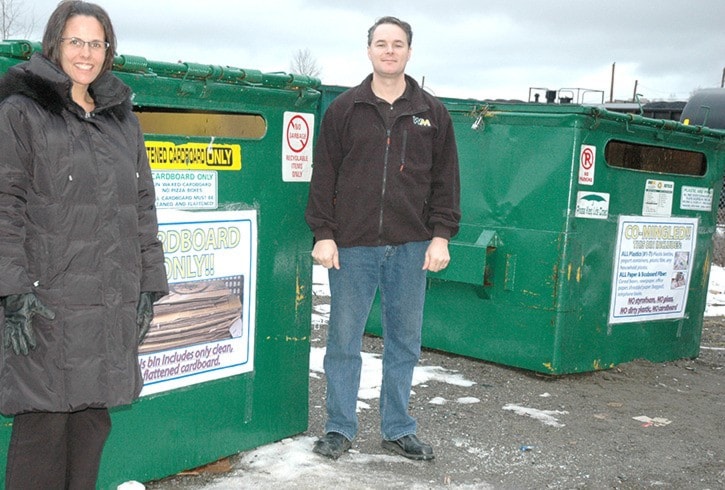New signs at Waste Management’s self-serve recycling depot have been posted to eliminate problems of material going into the wrong bins.
Signs with pictures and instructions about what can be recycled in bins were added late last month in an attempt to stop non-recyclables from being left at its Southside depot and to ensure that recyclable items are placed in the right bins.
Cardboard and boxboard have been getting mixed up and plastics which can’t be recycled are showing up, says Waste Management manager Jay Maybin.
A common misconception seems to be that any kind of plastic can be recycled, said Maybin.
Toys, household plastic blinds, car seats, plastic car parts, and other hard-permanent type plastic items are not accepted at the depot.
“It should be household plastics one through seven,” added Cindi Pohl, who also works for Waste Management, of numbers stamped into plastic items.
The number is generally located at the centre of three arrows making up a triangle.
The number shows what kind of plastic an object is made from.
“This is the tricky thing,” said Pohl. “Not everything has it.”
If there’s no number on an item someone wants to recycle, a good rule of thumb is whether or not there is flex to the plastic, she explained.
“If you can bend it, it’s probably recyclable,” added Maybin.
“If you can’t bend it, and it doesn’t have a number on it, it’s probably not recyclable,” said Pohl.
It is also important that plastics that can be dropped off are clean.
Just as tricky is the difference between cardboard and boxboard.
The bin for cardboard is for corrugated material of the kind used to make large boxes. It has a series of ridges in it, and will bend inward if one squeezes it between their fingers.
And while some boxes may be made with corrugated cardboard, boxboard is different. It’s thick and flat but pliable and is used, for example, to make cereal boxes. In the recycling world it belongs with paper products.
But overall, Waste Management is happy with the recycling program, said Maybin.
It has created one full-time job in the city, and bins are being tipped three times weekly, which shows good community participation, he said.
“It’s running smoothly,” Maybin said, adding the city’s original recycling drop-off pilot depot was a good indicator for demand.
There was heavy traffic over the Christmas holidays with the bins filling up quickly, causing WM at one point to temporarily close the depot until the bins could be cleared.
The Waste Management drop-off depot started up April 30 of last year, taking over for the city-run pilot that would have evolved into a full-time program had the company not offered the service for free. The city had slated $70,000 for recycling in Terrace and during its pilot project was collecting in bins at the old Co-op site.
Material collected at that site was taken by Geier Waste to be dropped off at Do Your Part Recycling in Thornhill.
The city had intended to have companies bid on the recycling depot job full-time before Waste Management offered to maintain a depot at no charge.
